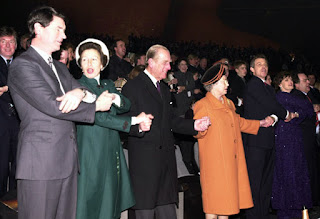
DLR Canary Wharf
Originally derided as the “Toytown Railway” when it opened in 1987 from Canary Wharf to a slightly off centre City terminus at Tower Gateway, the Docklands Light Railway (DLR) has developed to become a serious contributor to the transport infrastructure in East London and a critical component in the transport infrastructure for next years Olympics 2012 in London. The reputation of the DLR was further damaged by unreliability which plagued it for the first 5 years but it has developed in robustness and capacity over the years and is a firm favourite with visitors and natives alike – as they say in East London – “Don’t be a knocker, be a Docker!”

DLR with the Dome in the background
This innovative, driverless railway serves parts of East and South East London. Commuters and tourists alike enjoy views of lesser-seen London locations from the easily accessible DLR. It connects with the Tube network at Bank and Tower Gateway (Tower Hill) stations and also at Shadwell, Stratford, Bow, Heron Quays, Canning Town and Canary Wharf. The DLR serves Beckton, Stratford and London City Airport to the East and North East and the Docklands, Greenwich and Lewisham to the South.


DLR Network - Diagramatic & geographic maps
Being a light railway many of the routes use existing and often abandoned rail routes in East London which once served the huge Docks complexes which stretched for many miles along the River Thames. This has allowed cheaper, quicker construction with less planning issues and delays as part of the overall regeneration of an area which had experienced years of decline as the docks and associated industries closed.

DLR 3 car configuration
The Toytown Railway has comprehensively proved its detractors wrong as it extended its reach to London City Airport, Woolwich and Lewisham (taking in Greenwich) south of the river and Beckton and now Stratford International north of the river. Other capacity enhancements increasing the trains to 3 cars and connecting underground to the major Tube interchange at Bank Station have greatly increased the usefulness of the DLR network. Passengers for their part appreciate the easy access, automatic ticketing (integrated with TfL’s Oyster system) and the security from having onboard Train Captains. Kids and tourists alike love the fact that these are automatic driverless trains and there is always a rush to occupy the front row which gives a driver’s eye view of the route. This is particularly popular on the tunnel section from Bank where the trains emerge from the darkness and climb steeply on a viaduct which gives excellent views of Limehouse and the towers of Canary Wharf.

With just under a year to go to the London 2012 Paralympic Games the fully accessible Docklands Light Railway (DLR) Stratford International extension opened today (31 August), bringing this key link into the heart of the Olympic Park. This will also be the terminus for the “Olympic Javelin” which will ferry up to 25,000 people an hour to and from the Olympic Park. The journey time from St. Pancras in Central London to the Olympics will be only 7 minutes, an Olympic sprint indeed!
See; St. Pancras Reborn
http://daithaic.blogspot.com/2007/11/st-pancras-reborn.html
Spectators will get free use of public transport with their tickets to Olympic events but a separate Javelin pass may be issued to manage crowds. The project is a key part of the London 2012 Olympic and Paralympic transport network and will improve accessibility on London's transport network for people with restricted mobility. It was due to open in July 2010, however the extension is opening well ahead of the London 2012 Olympic and Paralympic Games.

System Map @ Elverson Road
The 3.7-mile (6km) expansion from Canning Town to Stratford International forms a key part of the London 2012 Olympic Games transport network. There are four new stations along the new route, which connects the Olympic Park to five arenas in east London. The four new stations are Stratford International, Stratford High Street, Abbey Road and Star Lane. This will be the last extension of the DLR system until the branch to Dagenham is completed in 2017.
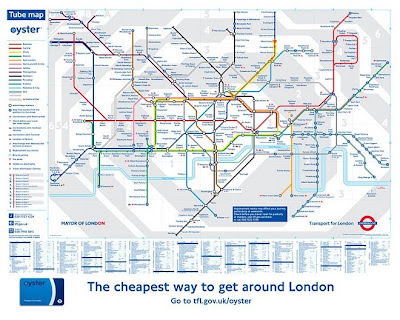
Docklands integrated with the TfL transport network
The extension completes a £500m upgrade of the Docklands Light Railway, which Transport for London (TfL) says will improve capacity by 50%. Mayor of London Boris Johnson said: "This expansion of the DLR is a further demonstration of the improvements that the London 2012 Games are making to our city.” This work will be of permanent benefit for Londoners and all those travelling in the capital from here on in. It's fantastic news and another example of London's lasting legacy of playing host to such a momentous event."

DLR train interior
Director of transport for the Olympic Delivery Authority, Hugh Sumner, said: "The opening of the new DLR extension is the last piece in the jigsaw for major upgrades and improvements to networks serving the Olympic Park. We have worked closely with TfL to fund and deliver a much-improved service which will leave east London better connected after the Games."
The Olympic venues served by the DLR are;
• Olympic Park: a 2.5 km2 site that will form the centre stage for the Games. It features purpose-built and accessible facilities including the Aquatics Centre, Velodrome and Olympic Stadium.
• ExCeL: is London’s largest exhibition and conference centre. During the Olympic Games it will host the Weightlifting, Judo, Fencing, Taekwondo, Table Tennis, Wrestling and Boxing. During the Paralympics it will host Table Tennis, Judo, Wheelchair Fencing, Boccia, Powerlifiting and Volleyball (Sitting).
• Greenwich Park: covers 74 hectares and is part of the Maritime Greenwich World Heritage Site. During the Olympic Games it will host the Equestrian events and Modern Pentathlon. During the Paralympic Games it will host the Equestrian Dressage.
• Royal Artillery Barracks: is owned and operated by the Ministry of Defence and will have a temporary venue beside Woolwich Common to host the Olympic Shooting event and the Paralympic Archery and Shooting events.
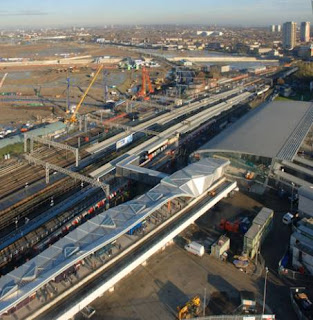
Stratford station in December 2009, showing the new DLR line and platforms under construction, this was formerly the North London Line platforms. The Olympic Park and Westfield Shopping Centre site is in the background.
The Docklands Light Railway is an automated light metro or light rail system opened on 31 August 1987 to serve the redeveloped Docklands area of London. It covers several areas of London, reaching north to Stratford, south to Lewisham, and west to Tower Gateway and Bank in the City of London financial district, and east to Beckton, London City Airport and Woolwich Arsenal.
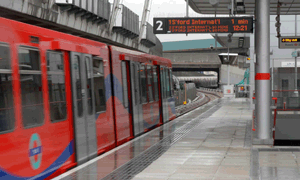

Stratford International DLR Station
The DLR is now 23 miles (37 km) long, with 44 stations along the route. There are five branches: to Lewisham in the south, to Stratford in the north, to Beckton and to Woolwich Arsenal in the east, and to Central London in the west, splitting to serve Bank and Tower Gateway. Although the layout allows many different combinations of routes, at present the following four are operated in normal service:
• Stratford to Lewisham
• Bank to Lewisham
• Bank to Woolwich Arsenal
• Tower Gateway to Beckton
There is an additional shuttle service from Canning Town to Prince Regent, operated when exhibitions are in progress at the ExCeL exhibition centre, to double the normal service. These trains reverse direction in the eastbound platform at Canning Town and on a crossover at the high point where the line crosses the Connaught Crossing road bridge between Prince Regent and Royal Albert stations.

Making transport accessible to all is important in London and has an added impetus for the Paralympic Games in 2012. All DLR stations have lift or ramp access to the platforms, with level access onto the trains. All lifts have alarms enabled, which allow you to talk directly with a member of DLR staff should you experience any problems. Platforms are as level with trains as possible for easy access. The gap between the platform edge and the train is approximately 7.5cm wide and the step up/down from the platform to the train approximately 5cm high. Most wheelchair users find boarding/alighting smoothest with the largest wheel first – this may mean reversing as appropriate.

Elsewhere on the TfL transport network all of London's 8,500 buses are fully accessible, all 22,000 taxis have wheelchair ramps and all stations and trains on the DLR network are fully accessible. 62 Tube stations are now step-free from street to platform, and this will rise further with the imminent completion of works at Green Park, which will be a key step-free station during the Games. By the time of the 2012 Games 65 Tube stations will be step-free.
The DLR runs from 5.30am to 12.30am Monday to Saturday and from 7am to 11.30pm on Sunday. Fares are the same as those on the Tube and Oyster and Travelcard holders can use the DLR.
The Opening Ceremony of the Olympic Games will take place on 27 July 2012 and the Closing Ceremony on the 12 Aug 2012. 18 days later, the Paralympic Games (the second largest event of its kind in the world) will stage its Opening Ceremony. Odds are that many attending the ceremonies and events of London 2012 will be travelling on the Docklands Railway.
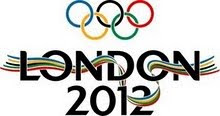
Docklands Light Railway website;
www.dlr.co.uk
See also;
London Olympics 2012 – Stratford Station
http://daithaic.blogspot.com/2009/01/london-olympics-2012-stratford-station.html
Paralympic Games
http://daithaic.blogspot.com/2008/09/paralympic-games.html







